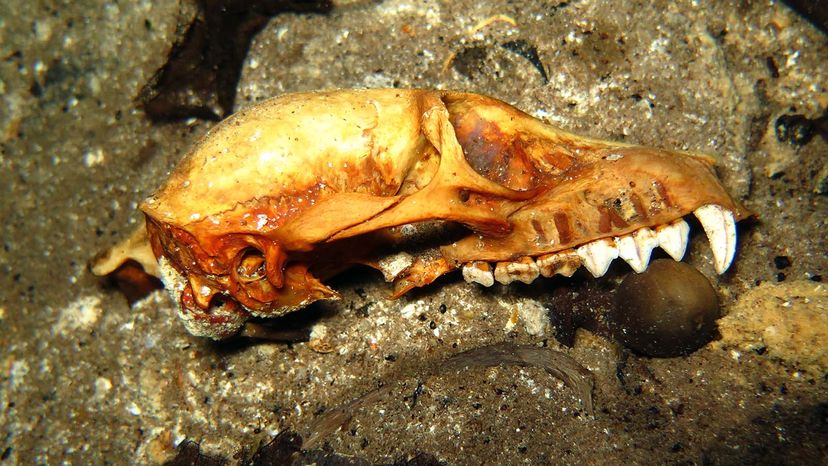
Researchers in Madagascar discovered the remains of a horned crocodile in a water-filled cave. Barry Coleman
Winding through the South Carolina low country, the Cooper River is a reed-lined haven for sportfish and shorebirds. The waterway originates in Berkeley County’s Lake Moultrie. From there, it proceeds all the way down to Charleston, where it merges with the Ashley and the Wando to form that city’s world-famous harbor. (Ever hear of Fort Sumter?)
The Cooper River took its name from Anthony Ashley Cooper, a 17th-century English lord. As time wore on, it became a lifeline in the region’s burgeoning rice trade. But the Cooper also bears the hallmarks of a far more ancient chapter in South Carolina history.
If you know where to look, and you’ve got scuba gear handy, you just might find a mammoth tusk lurking beneath the water’s surface.
Matthew Weas knows that feeling. He and his father, Joe Harvey, are experienced local divers who patrol the Cooper for fossils — many of which end up on display at the Berkeley County Museum in Moncks Corner, South Carolina.
Not all the giants they encounter are prehistoric. To hear Weas tell it, run-ins with living modern-day river-beasts aren’t uncommon. “I have had a [catfish] swallow my hand in a log jam underwater, a manatee break the surface while I was swimming back to the boat… [and] alligators swim toward me,” he says via email. Once, he came “nose-to-nose” with a gator measuring about 10 feet (3 meters) long.

This skull was from an extinct lemur that was part of a primate community in Madagascar that disappeared during the last 1,100 years.
Barry Coleman
Cave of Wonders
The American alligator may be synonymous with the South, but underwater fossil-hunting is a global pastime. Outside the U.S., divers have encountered paleo-treasures in such places as Australia, Bali, Brazil, Indonesia, Mexico and the Bahamas.
Back in 2014, a bona fide “lemur graveyard” was discovered in the submerged caves of Madagascar’s Tsimanampetsotsa National Park. The big find was made possible by an international collaborative effort between anthropologists, paleontologists and scuba divers.
Hundreds of bones appeared in the underwater sediments. Some came from contemporary species like the invasive black rat. Other remains were left behind by animals that went extinct within the past few millennia.
The site quickly established itself as the world’s biggest cache of Pachylemur fossils. An ancient relative of the ruffed lemur, this creature was about twice as heavy, weighing an estimated 22 pounds (10 kilograms). It would’ve been utterly dwarfed by the gorilla-sized Mesopropithecus, a gargantuan lemur also represented in these caves.
Pygmy hippo, elephant bird and horned crocodile material was also recovered by the dive team — along with the rare, virtually complete skull of yet another bygone lemur species.
Getting access to the bounty wasn’t easy. The caves in question were likely dry at some point, but today they’re part of a flooded sinkhole. Right now, the system’s most fossil-laden cave runs 82 feet (25 meters) deep. It’s a dark environment with a complex layout, full of horizontal passageways and murky waters.
In short, this is no place for novice divers. Cave-diving in general is a high-risk sport; if you wander off-course, you can’t always ascend straight up to the surface. So to avoid getting lost, the scuba specialists on that 2014 team tracked their pathways with about 879 feet (268 meters) of safety lines.

This 30-inch piece of Mastodon tusk was recovered during a dive in the Cooper River in South Carolina.
Joe Harvey
Preparation Is Key
Another precious sinkhole is the Page-Ladson site in northwestern Florida. Hidden below the Aucilla River, it’s yielded some of the oldest-known human artifacts in North America. Equally fascinating are the locality’s mastodon bones, including some 14,550-year-old fossils bearing scars that suggest the animals were butchered by ancient Floridians.
Here, tannins are a real nuisance. A vital component in leather, tannins are chemical compounds released by various plants. When these seep into ponds or rivers, they can turn the water blackish-brown. Needless to say, this impairs visibility. In some corners of the Aucilla, the tannins help block out sunlight, shrouding everything deeper than 10 feet (3 meters) beneath the surface in inky darkness.
Back north in the Cooper River, divers face this same problem. To see clearly, they — and their Aucilla-based colleagues — make good use of high-wattage underwater lights.
Weas says he and his father wear Dive-Rite “cave lights” attached to their helmets. The rest of the duo’s equipment would look pretty familiar to other recreational divers. “We use the standard tank, regulators and BCDs,” Weas says. (For the record, BCD stands for “Buoyancy Compensating Device,” a wearable gadget used to keep divers at their desired depth.)
On summer dives, Weas and Harvey can comfortably don pants and T-shirts. But under some weather conditions, dry suits, semi-dry suits or wetsuits might be more appropriate. Since the Cooper gets strong tidal currents, the water’s speed at any given moment affects their schedule. Faster currents make for shorter excursions.

This cache from a dive in the Cooper River includes several shark’s teeth as well as a brass Colonial belt buckle.
Joe Harvey
Giant Sharks … And Beavers?!
Why do people go through all this trouble when there are loads of fossils hanging out on dry land? Well for one thing, immersion in water has some preservation benefits. Deep in the bowels of a sunken cave, bones are less likely to be disturbed — either by scavengers or the ravages of open-air climates.
And whereas land fossils are often caked in rock, some of the bones in flowing rivers get polished clean by the currents.
Most of the material Weas discovers out in the Cooper River comes from two different points in geologic time. The river’s most sought-after fossils are probably shark teeth from the Miocene Epoch, which lasted from 23 million to 5.3 million years ago. Some of these chompers get quite large: A tooth from the extinct megalodon shark can be up to 7.6 inches (19.3 centimeters) long!
“Shark’s teeth are the most common finds,” says Weas, “though whale ear bones come [in] a close second.”
Other Cooper River fossils were laid down during the more recent Pleistocene Epoch. That began just 2.6 million years ago and ended a mere 11,700 years before the present. Back then, sea levels were lower and the Carolina coastline lay farther to the east.
Over the years, Weas and Harvey have extricated the bones of Pleistocene mammoths, capybaras, hoofed herbivores — and giant beavers. The latter calls for an explanation. During the last ice age, North American wetlands were occupied by Castoroides, 8-foot (2.5-meter) beavers that likely weighed 220 pounds (100 kilograms) or more.
Having a manatee sneak up on you is undoubtedly scary. But just imagine taking a dip with one of those mega-rodents! Thanks, but no thanks.
Note: This article have been indexed to our site. We do not claim legitimacy, ownership or copyright of any of the content above. To see the article at original source Click Here












